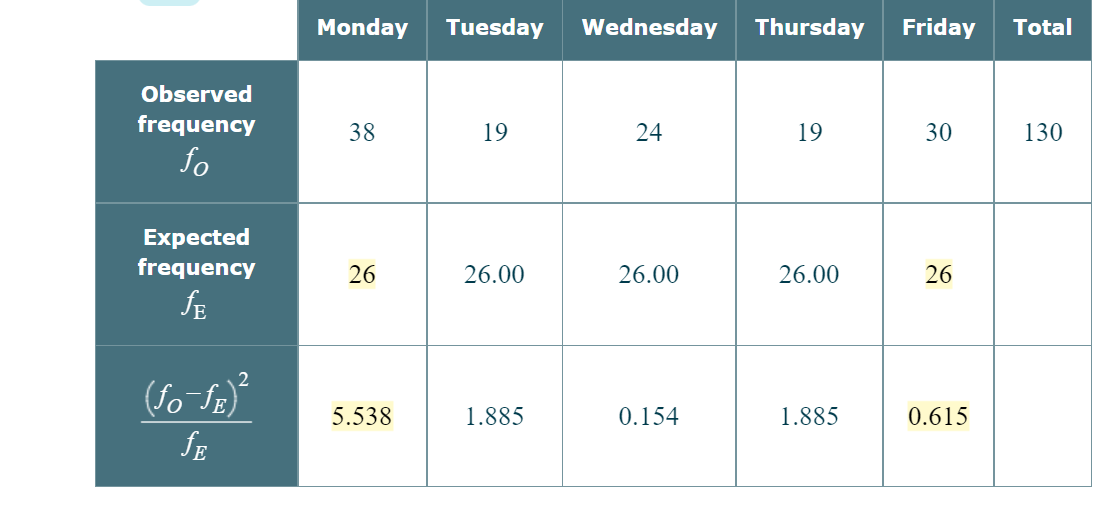Does it seem to you that people tend to be absent more on some days of the week than on others? Recently, a major biotechnology firm collected data with the hope of determining whether or not its employees were more likely to be absent on some weekdays than on others. The firm examined a random sample of 130 employee absences. The distribution of these 130 absences is shown in the table below. The observed frequency for each category (each weekday) is shown in the first row of numbers. The second row of numbers contains the frequencies expected for a sample of 130 employees if employee absences at the firm are equally likely on each of the five weekdays. The bottom row of numbers contains the following value for each of the categories. (fo-fe)² JE (Observed frequency - Expected frequency)² Expected frequency
Does it seem to you that people tend to be absent more on some days of the week than on others? Recently, a major biotechnology firm collected data with the hope of determining whether or not its employees were more likely to be absent on some weekdays than on others. The firm examined a random sample of 130 employee absences. The distribution of these 130 absences is shown in the table below. The observed frequency for each category (each weekday) is shown in the first row of numbers. The second row of numbers contains the frequencies expected for a sample of 130 employees if employee absences at the firm are equally likely on each of the five weekdays. The bottom row of numbers contains the following value for each of the categories. (fo-fe)² JE (Observed frequency - Expected frequency)² Expected frequency
Glencoe Algebra 1, Student Edition, 9780079039897, 0079039898, 2018
18th Edition
ISBN:9780079039897
Author:Carter
Publisher:Carter
Chapter10: Statistics
Section10.4: Distributions Of Data
Problem 19PFA
Related questions
Question

Transcribed Image Text:Does it seem to you that people tend to be absent more on some days of the week than on others? Recently, a major biotechnology firm collected data with
the hope of determining whether or not its employees were more likely to be absent on some weekdays than on others. The firm examined a random sample
of 130 employee absences.
The distribution of these 130 absences is shown in the table below. The observed frequency for each category (each weekday) is shown in the first row of
numbers. The second row of numbers contains the frequencies expected for a sample of 130 employees if employee absences at the firm are equally likely on
each of the five weekdays. The bottom row of numbers contains the following value for each of the categories.
(fo-fE)²
ƒE
(Observed frequency - Expected frequency)²
Expected frequency

Transcribed Image Text:Observed
frequency
fo
Expected
frequency
ƒE
2
(ƒo¯ƒE)²
JE
Monday Tuesday Wednesday Thursday Friday Total
38
26
5.538
19
26.00
1.885
24
26.00
0.154
19
26.00
1.885
30
26
0.615
130
Expert Solution
This question has been solved!
Explore an expertly crafted, step-by-step solution for a thorough understanding of key concepts.
This is a popular solution!
Trending now
This is a popular solution!
Step by step
Solved in 5 steps with 1 images

Recommended textbooks for you

Glencoe Algebra 1, Student Edition, 9780079039897…
Algebra
ISBN:
9780079039897
Author:
Carter
Publisher:
McGraw Hill

Holt Mcdougal Larson Pre-algebra: Student Edition…
Algebra
ISBN:
9780547587776
Author:
HOLT MCDOUGAL
Publisher:
HOLT MCDOUGAL

Glencoe Algebra 1, Student Edition, 9780079039897…
Algebra
ISBN:
9780079039897
Author:
Carter
Publisher:
McGraw Hill

Holt Mcdougal Larson Pre-algebra: Student Edition…
Algebra
ISBN:
9780547587776
Author:
HOLT MCDOUGAL
Publisher:
HOLT MCDOUGAL